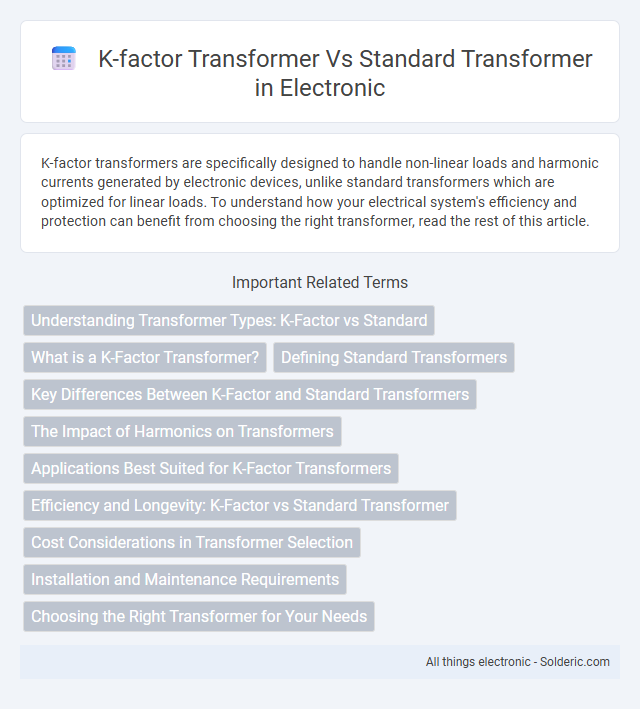K-factor transformers are specifically designed to handle non-linear loads and harmonic currents generated by electronic devices, unlike standard transformers which are optimized for linear loads. To understand how your electrical system's efficiency and protection can benefit from choosing the right transformer, read the rest of this article.
Comparison Table
| Feature | K-Factor Transformer | Standard Transformer |
|---|---|---|
| Purpose | Handles non-linear loads with harmonic currents | Designed for linear, sinusoidal loads |
| Design | Reinforced windings, increased thermal capacity | Standard winding and insulation |
| Harmonic Handling | High tolerance to harmonic distortion (K-factor rating) | Low tolerance, prone to overheating from harmonics |
| Applications | Data centers, UPS systems, variable frequency drives | General industrial and commercial use with linear loads |
| Cost | Higher initial cost due to specialized design | Lower cost, standard manufacturing |
| Efficiency | Maintains efficiency under harmonic stress | Efficiency decreases with harmonic loads |
| Thermal Performance | Enhanced thermal management to prevent overheating | Standard thermal limits |
Understanding Transformer Types: K-Factor vs Standard
K-factor transformers are designed to handle non-linear loads that generate harmonic currents, protecting your electrical system from overheating and reduced lifespan. Standard transformers are optimal for linear loads with minimal harmonic distortion, providing efficient voltage regulation under typical conditions. Choosing the right transformer type ensures improved performance and longevity based on your specific load requirements.
What is a K-Factor Transformer?
A K-factor transformer is specifically designed to handle the additional heat generated by harmonic currents produced by nonlinear loads in electrical systems. Unlike standard transformers, which are rated primarily for sinusoidal load currents, K-factor transformers have reinforced insulation and enhanced cooling capabilities to safely manage harmonic distortion without overheating. Your electrical system benefits from improved reliability and longevity when using a K-factor transformer in environments with variable frequency drives, UPS systems, or other harmonic-generating equipment.
Defining Standard Transformers
Standard transformers are electrical devices designed primarily for transferring power between circuits with minimal loss, operating efficiently under typical linear load conditions. They lack specialized insulation and construction features necessary to handle harmonics or non-linear loads effectively. Your system may require a K-factor transformer instead if it experiences significant harmonic distortion, as standard transformers are vulnerable to overheating and premature failure in such environments.
Key Differences Between K-Factor and Standard Transformers
K-factor transformers are specifically designed to handle non-linear loads with harmonic currents, protecting your electrical system from overheating and premature failure, unlike standard transformers which are built for linear loads with minimal harmonic distortion. Key differences include enhanced winding insulation, robust construction, and the ability to dissipate heat generated by harmonic currents, making K-factor transformers ideal for environments with electronic devices and variable frequency drives. Your choice depends on the load type, where K-factor transformers ensure reliability and efficiency in high harmonic conditions compared to standard transformers.
The Impact of Harmonics on Transformers
K-factor transformers are engineered to handle harmonic currents generated by non-linear loads, reducing overheating and insulation damage compared to standard transformers. Harmonics cause increased eddy currents and losses, leading to excessive heating in standard transformers not designed for this stress. Using K-factor transformers enhances reliability and longevity in environments with significant harmonic distortion by mitigating these detrimental thermal and electrical effects.
Applications Best Suited for K-Factor Transformers
K-factor transformers are specifically designed to handle non-linear loads prone to producing harmonic currents, such as computers, data centers, and variable frequency drives, making them ideal for modern electronic equipment environments. These transformers provide enhanced protection against overheating and premature insulation failure caused by harmonics, which standard transformers typically cannot manage effectively. Your electrical system benefits from improved reliability and longer transformer lifespan when using K-factor transformers in applications with significant harmonic distortion.
Efficiency and Longevity: K-Factor vs Standard Transformer
K-factor transformers demonstrate higher efficiency in managing harmonic distortions compared to standard transformers, reducing energy losses and thermal stress. Their design accommodates non-linear loads, which enhances longevity by minimizing insulation degradation and overheating risks. Standard transformers, lacking this specialized construction, often experience reduced lifespan and efficiency in environments with significant harmonic currents.
Cost Considerations in Transformer Selection
K-factor transformers typically have higher upfront costs compared to standard transformers due to their specialized design for handling harmonic currents caused by nonlinear loads. However, investing in a K-factor transformer can reduce maintenance expenses and extend equipment life by minimizing overheating and insulation degradation. Your decision should weigh the initial cost against potential long-term savings and improved system reliability when selecting the appropriate transformer type.
Installation and Maintenance Requirements
K-factor transformers require specialized installation techniques to handle harmonic loads and prevent overheating, ensuring longevity and reliability in environments with variable loads. Standard transformers have simpler installation processes but may suffer from reduced efficiency and increased heating when exposed to non-linear loads. Your choice impacts maintenance frequency, as K-factor transformers demand regular monitoring for harmonic distortion, while standard transformers typically require routine inspections without advanced harmonic considerations.
Choosing the Right Transformer for Your Needs
K-factor transformers are designed to handle non-linear loads and harmonic currents commonly produced by sensitive electronics and variable frequency drives, making them ideal for industrial and commercial environments. Standard transformers suit general power distribution with linear loads, focusing on efficiency and simplicity in applications without significant harmonic distortion. Selecting the right transformer depends on load characteristics, with K-factor transformers offering enhanced durability and performance where harmonics are present, while standard transformers remain cost-effective for traditional, linear loads.
K-factor transformer vs standard transformer Infographic

 solderic.com
solderic.com